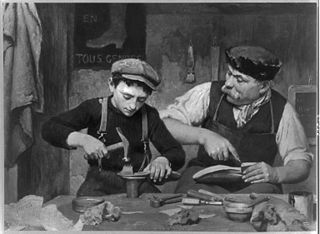
A guild is an association of artisans and merchants who oversee the practice of their craft/trade in a particular territory. The earliest types of guild formed as organizations of tradespeople belonging to a professional association. They sometimes depended on grants of letters patent from a monarch or other ruler to enforce the flow of trade to their self-employed members, and to retain ownership of tools and the supply of materials, but most were regulated by the city government. Guild members found guilty of cheating the public would be fined or banned from the guild. A lasting legacy of traditional guilds are the guildhalls constructed and used as guild meeting-places.

Vocational education is education that prepares people to work as a technician or to take up employment in a skilled craft or trade as a tradesperson or artisan. Vocational Education can also be seen as that type of education given to an individual to prepare that individual to be gainfully employed or self employed with requisite skill. Vocational education is known by a variety of names, depending on the country concerned, including career and technical education, or acronyms such as TVET and TAFE.

Apprenticeship is a system for training a new generation of practitioners of a trade or profession with on-the-job training and often some accompanying study. Apprenticeships can also enable practitioners to gain a license to practice in a regulated occupation. Most of their training is done while working for an employer who helps the apprentices learn their trade or profession, in exchange for their continued labor for an agreed period after they have achieved measurable competencies.

Carpentry is a skilled trade and a craft in which the primary work performed is the cutting, shaping and installation of building materials during the construction of buildings, ships, timber bridges, concrete formwork, etc. Carpenters traditionally worked with natural wood and did rougher work such as framing, but today many other materials are also used and sometimes the finer trades of cabinetmaking and furniture building are considered carpentry. In the United States, 98.5% of carpenters are male, and it was the fourth most male-dominated occupation in the country in 1999. In 2006 in the United States, there were about 1.5 million carpentry positions. Carpenters are usually the first tradesmen on a job and the last to leave. Carpenters normally framed post-and-beam buildings until the end of the 19th century; now this old-fashioned carpentry is called timber framing. Carpenters learn this trade by being employed through an apprenticeship training—normally 4 years—and qualify by successfully completing that country's competence test in places such as the United Kingdom, the United States, Canada, Switzerland, Australia and South Africa. It is also common that the skill can be learned by gaining work experience other than a formal training program, which may be the case in many places.
A journeyman is a worker, skilled in a given building trade or craft, who has successfully completed an official apprenticeship qualification. Journeymen are considered competent and authorized to work in that field as a fully qualified employee. They earn their license by education, supervised experience and examination. Although journeymen have completed a trade certificate and are allowed to work as employees, they may not yet work as self-employed master craftsmen.

An electrician is a tradesperson specializing in electrical wiring of buildings, transmission lines, stationary machines, and related equipment. Electricians may be employed in the installation of new electrical components or the maintenance and repair of existing electrical infrastructure. Electricians may also specialize in wiring ships, airplanes, and other mobile platforms, as well as data and cable lines.

Legal education is the education of individuals in the principles, practices, and theory of law. It may be undertaken for several reasons, including to provide the knowledge and skills necessary for admission to legal practice in a particular jurisdiction, to provide a greater breadth of knowledge to those working in other professions such as politics or business, to provide current lawyers with advanced training or greater specialisation, or to update lawyers on recent developments in the law.

A tradesman, tradeswoman, or tradesperson is a skilled worker that specializes in a particular trade. Tradesmen usually have work experience, on-the-job training, an apprenticeship program or formal education.

Education in Germany is primarily the responsibility of individual German states, with the federal government playing a minor role. Optional Kindergarden education is provided for all children between one and six years old, after which school attendance is compulsory. Overall, Germany is one of the best performing OECD countries in reading literacy, mathematics and sciences with the average student scoring 515 in the PISA Assessment Test, well above the OECD average of 497 points. Germany has a less competitive system, leading to low rates of bullying and students having a weak fear of failure but a high level of self-confidence and general happiness compared to other OECD countries like South Korea. Additionally, Germany has one of the largest percentage of top performers in reading among socio-economically advantaged students, ranking 3rd out of 76 OECD countries. This leads to Germany having one of the highest-educated labour forces among OECD countries. The Human Rights Measurement Initiative finds that Germany is achieving 75.4% of what should be possible for the right to education, at their level of income.

Historically, a master craftsman or master tradesman was a member of a guild. The title survives as the highest professional qualification in craft industries.

A vocational school, trade school, or technical school is a type of educational institution, which, depending on the country, may refer to either secondary or post-secondary education designed to provide vocational education or technical skills required to complete the tasks of a particular and specific job. In the case of secondary education, these schools differ from academic high schools which usually prepare students who aim to pursue tertiary education, rather than enter directly into the workforce. With regard to post-secondary education, vocational schools are traditionally distinguished from four-year colleges by their focus on job-specific training to students who are typically bound for one of the skilled trades, rather than providing academic training for students pursuing careers in a professional discipline. While many schools have largely adhered to this convention, the purely vocational focus of other trade schools began to shift in the 1990s "toward a broader preparation that develops the academic" as well as technical skills of their students.
Meister means 'master' in German. The word is akin to master and maestro. In sports, Meister is used for the current national, European or world champion.

The term German model is most often used in economics to describe post-World War II West Germany's means of using innovative industrial relations, vocational training, and closer relationships between the financial and industrial sectors to cultivate economic prosperity. The two key components of the German model is a national system for certifying industrial and artisan skills, as well as full union participation in the oversight of plant-based vocation training.

A glazier is a tradesman responsible for cutting, installing, and removing glass. They also refer to blueprints to figure out the size, shape, and location of the glass in the building. They may have to consider the type and size of scaffolding they need to stand on to fit and install the glass. Glaziers may work with glass in various surfaces and settings, such as cutting and installing windows, doors, shower doors, skylights, storefronts, display cases, mirrors, facades, interior walls, ceilings, and tabletops.

Paramedics in Germany are the main providers of emergency care in emergency medical services in Germany. There exist two professional levels regulated by federal law, the Rettungsassistent and the Notfallsanitäter.
A dual education system combines apprenticeships in a company and vocational education at a vocational school in one course. This system is practiced in several countries, notably Germany, Austria, Switzerland and in the German-speaking Community of Belgium, but also for some years now in South Korea.
An admission to practice law is acquired when a lawyer receives a license to practice law. In jurisdictions with two types of lawyer, as with barristers and solicitors, barristers must gain admission to the bar whereas for solicitors there are distinct practising certificates.
Instrument mechanics in engineering are tradesmen who specialize in installing, troubleshooting, and repairing instrumentation, automation and control systems. The term "Instrument Mechanic" came about because it was a combination of light mechanical and specialised instrumentation skills. The term is still is used in certain industries; predominantly in industrial process control.
Apprenticeships have a long tradition in the United Kingdom, dating back to around the 12th century. They flourished in the 14th century and were expanded during the industrial revolution. In modern times, apprenticeships were formalised in 1964 by act of parliament and they continue to be in widespread use to this day.
Apprenticeship programs in the United States are regulated by the Smith–Hughes Act (1917), The National Industrial Recovery Act (1933), and National Apprenticeship Act, also known as the "Fitzgerald Act."















